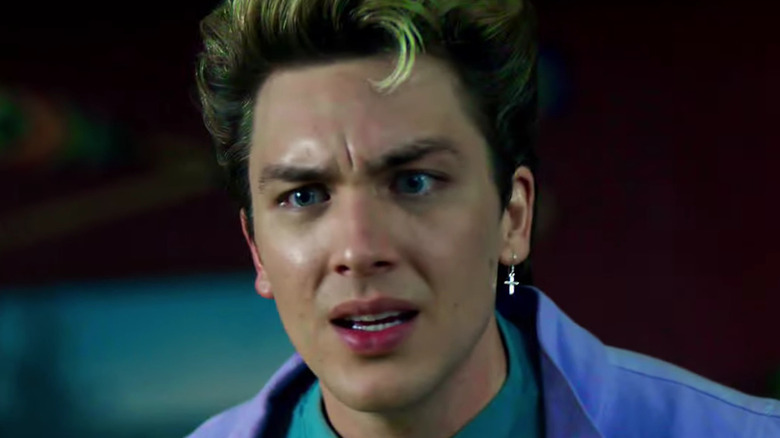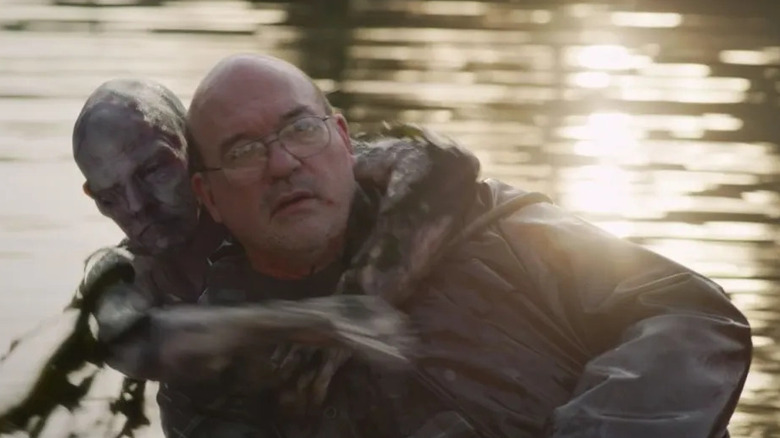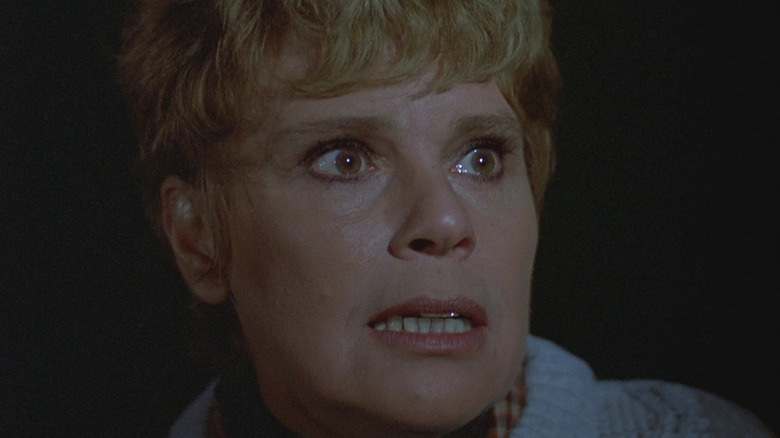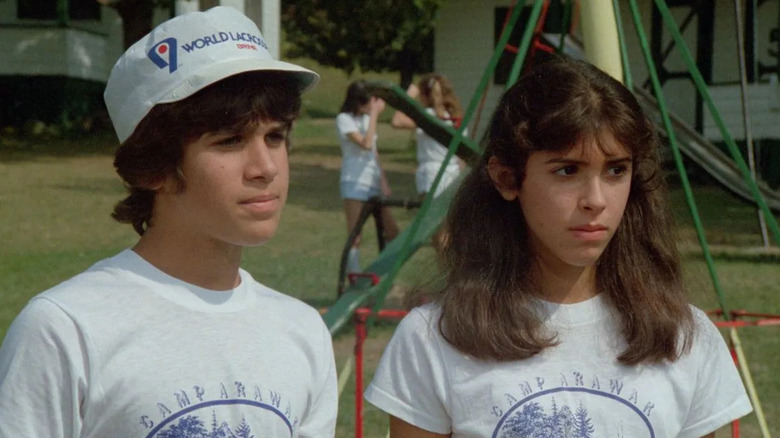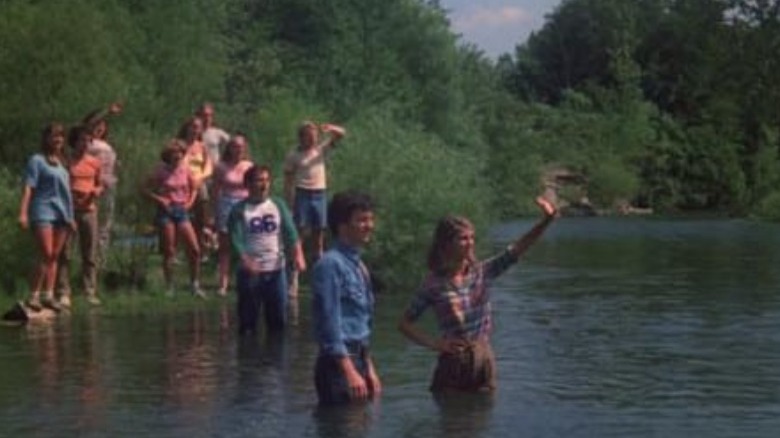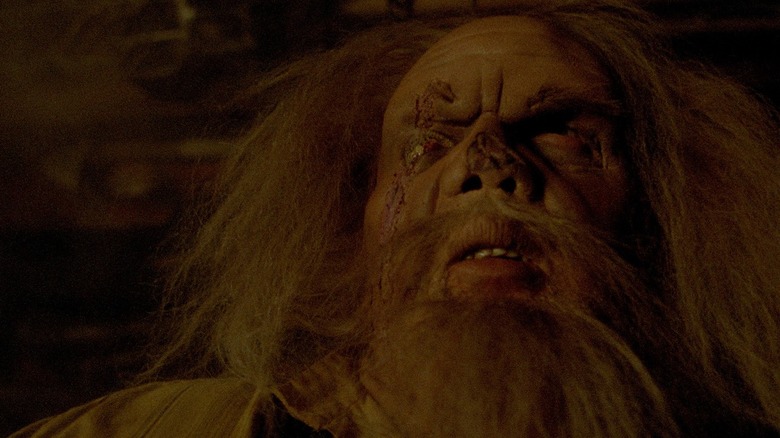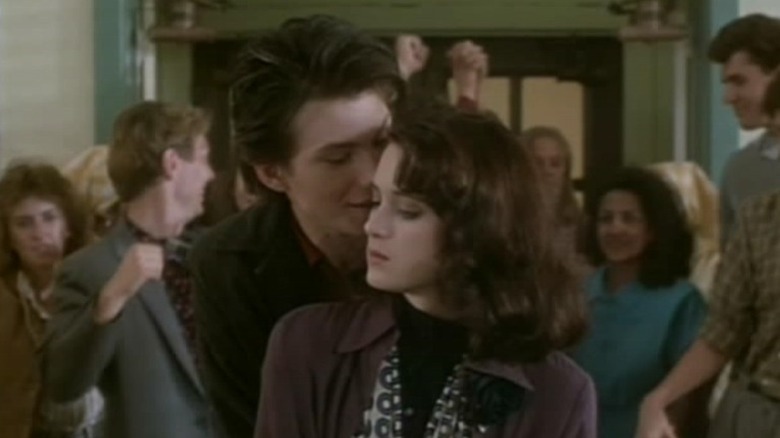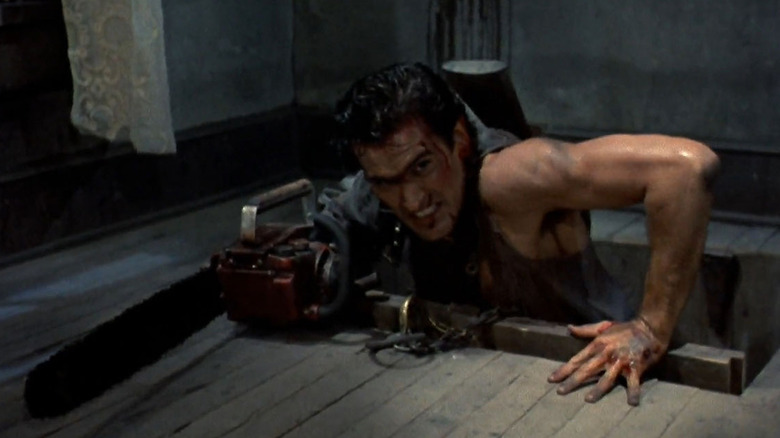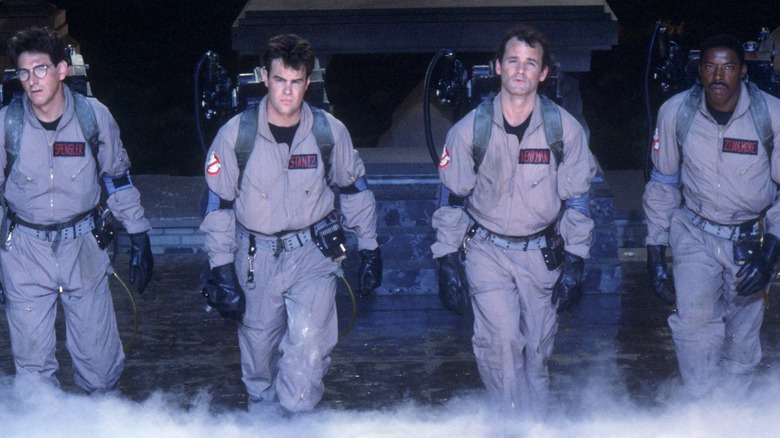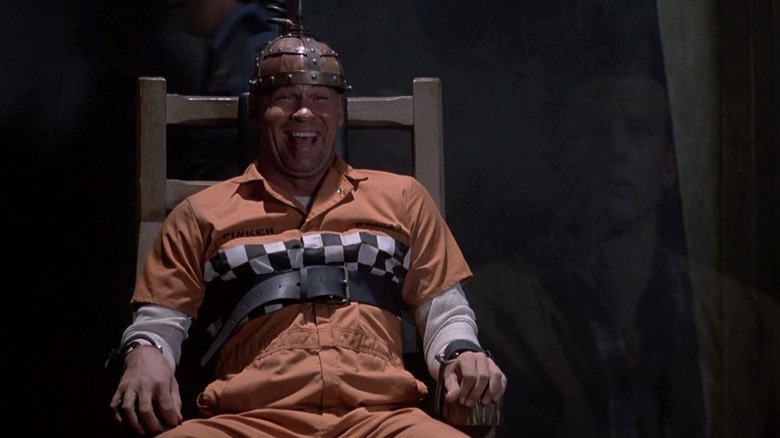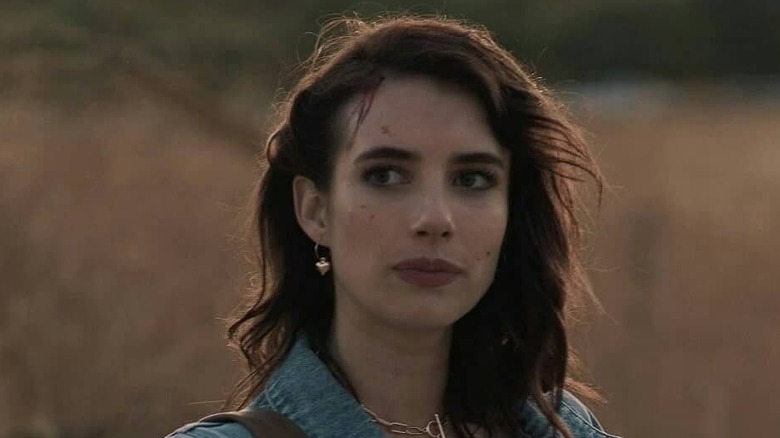The '80s Horror Movie References You Likely Missed In AHS 1984
The ninth season of "American Horror Story" was an unexpectedly fresh, welcome addition to the popular FX series' overall continuity. Compared to earlier seasons, Season 9's stylized approach to the campy slasher subgenre allowed "American Horror Story" to abandon its usual, darker horror presentation and adopt a style and tone distinctly different from anything else the show had done in the past.
Heavily inspired films from the subgenre's golden period in the late '70s and '80s, "American Horror Story: 1984" takes place at a remote summer camp in the woods, focusing on a group of counselors being picked off one by one by a mysterious, unstable serial killer. The season's setting and tone are, of course, highly reminiscent of "Friday the 13th" movies, with "American Horror Story" also going out of its way to reference numerous songs, hairstyles and clothing trends, along with plenty of movies and TV shows that clearly serve as a major influence on the look and feel of "American Horror Story: 1984."
Some of these movies are bound to be obvious for slasher fans, such as "Halloween" and "Friday the 13th," which are easily the most standout influences on "American Horror Story: 1984." However, showrunner Ryan Murphy also references lesser-known slashers, many of which even the most astute horror fan might have missed upon their initial viewing. Here are all the references to 1980s horror movies that "American Horror Story: 1984" makes that you might not have noticed.
Specific Friday the 13th references
As mentioned, "Friday the 13th" serves as perhaps the most significant influence on "American Horror Story: 1984," which has a very similar plotline to the classic slasher film. While some resemblances between the two are obvious, casual viewers might miss some of the more specific homages that "American Horror Story" makes to the popular series.
For instance, Episode 8, "Rest in Pieces," features a scene taken straight from "Friday the 13th." As rampaging killer Mr. Jingles is thrown into a boat by Trevor and slowly bleeds out in the middle of the lake, he stares serenely at Montana, who is standing on the shore. The tranquil quality of the scene is abruptly cut short by the sudden appearance of the rotting, water-logged corpse of Jingles' younger brother, Bobby, who grabs Jingles and drags him into the lake.
This scene is pretty much a shot-for-shot recreation of the final sequence of the original "Friday the 13th." There, the sole survivor of Mrs. Voorhees' massacre, Alice, floats in the middle of Crystal Lake as police officers await her on the shore. As she prepares for her imminent rescue, the bloated corpse of a young Jason Voorhees appears behind her, pulling her into the lake. Not only does the scene resemble the ending for "Friday the 13th," but the manner in which Bobby drowned in the first place is similar to the circumstances of Jason's death in the "Friday the 13th" films. After all, both were young children killed in tragic accidents caused by the inattentiveness of the person who was supposed to be watching them — Mr. Jingles in "American Horror Story" and promiscuous camp counselors in "Friday the 13th."
Similar character types and plot twists to the original Friday the 13th
Additionally, there are a few other references that "American Horror Story: 1984" makes to the "Friday the 13th" movies. For instance, there is the helpful gas station attendant in Episode 1 played by Don Swayze, who tries to warn the main characters to stay away from Camp Redwood. A very similar character can also be spotted in the original "Friday the 13th" film in the form of Crazy Ralph, a local eccentric who tells the main characters that they'll likely wind up dead if they travel to Camp Crystal Lake.
In addition, the fact that the killer in "American Horror Story: 1984" is revealed to be a woman is likely a nod to the first "Friday the 13th." Similar to "American Horror Story: 1984," the first act of "Friday the 13th" hints that the killer is the vengeful spirit of Jason Voorhees, resulting in the unexpected twist that the killer is actually a female character that the campers — and the viewers — initially believed to be harmless.
Sleepaway Camp
It's easy to see the similarities between the "Friday the 13th" movies and "American Horror Story: 1984" by looking at the setting and general story. However, "Friday the 13th" isn't the only slasher to influence "American Horror Story: 1984," as the 1983 slasher film "Sleepaway Camp" is also referenced in "American Horror Story: 1984."
Cashing in on the financial success of "Friday the 13th," "Sleepaway Camp" takes place at a summer camp (as you may have guessed) and follows a group of counselors and teenage campers who are brutally murdered by an unseen killer. However, there is an important resemblance between a key character in "1984" and the main character of "Sleepaway Camp."
The appearance and personality of the main antagonist of "American Horror Story: 1984," Margaret Booth, who initially appears to be a bookish prude but is revealed to be the true mastermind behind Camp Redwood's murders, mirrors that of Angela Baker in "Sleepaway Camp." Just as in "Sleepaway Camp," the plot of "American Horror Story: 1984" hinges on a quiet young girl whose introverted nature makes her seem like the main hero of "Sleepaway Camp." In reality, though, this seemingly innocent girl turns out to be the person responsible for murdering her fellow campers.
Having the seeming heroine of the story serve as the movie's antagonist is a great plot twist that few other slashers had pulled off before, propelling "Sleepaway Camp" to its current cult status among horror fans. With that in mind, it's clear that "American Horror Story: 1984" takes more than a little inspiration from the film when its central plot twist.
The Burning
Another film that seems to significantly influence "American Horror Story: 1984" is "The Burning." In this 1981 cult slasher film, a group of campers is stalked by a hulking masked murderer seeking revenge for a prank gone wrong. Like "Friday the 13th" and "Sleepaway Camp," there are plenty of surface-level connections between "American Horror Story: 1984" and the film's summer camp setting. However, there is one crucial resemblance that "1984" has to "The Burning" specifically.
In "1984," the supposed Camp Redwood killer of 1970 was the camp's custodian, Benjamin Richter, or Mr. Jingles. After being arrested and institutionalized for his alleged crimes, Mr. Jingles is subjected to inhumane treatment methods that cause him to believe he was responsible for the massacre. He breaks out of the mental asylum in 1984 and ventures back to Camp Redwood to "finish what he started" 14 years ago.
While Mr. Jingles seems to be an amalgamation of a few different fictional serial killers, his backstory and role in "1984" primarily come across as a blend between Jason Voorhees and Michael Myers. However, his appearance in "1984" also resembles Cropsy, the main antagonist of "The Burning." As seen in that film, Cropsy is a caretaker at a local summer camp who is horribly burned in a cruel prank by the teenage campers. After being treated for five years at a local hospital, he is let loose, journeying to another summer camp to exact terrible vengeance against the campers and counselors.
Like Cropsy, Mr. Jingles was employed at a summer camp before launching into his career as a serial killer, and both characters share a homicidal hatred of campers stemming from their traumatic experiences at their respective camps. Beyond that, both travel directly from hospital settings to carry out their murderous vengeance.
Madman
The summer camp is the archetypical setting for dozens of slasher films released during the subgenre's golden age in the 1980s. One of the lesser-known slashers that similarly utilizes a summer camp setting is 1982's "Madman," which seems to serve as a minor source of inspiration for "American Horror Story: 1984."
"Madman" follows a group of campers who summon an axe-wielding mass murderer known as Madman Marz, who supposedly escaped into the woods after killing his wife and children, only to begin stalking and murdering any young campers who say his name aloud.
The influence of "Madman" on "1984" is a slight one, with the key similarity between the two being their main killers. Like Cropsy from "The Burning," Mr. Jingles' role in "1984" seems very similar to Madman Marz. Both Marz and Jingles are depicted as unkempt killers and local boogeymen with an affinity for killing clueless campers and camp counselors. At one point in the series, Mr. Jingles even wields an axe to dispatch Ray — an all too knowing nod to the main antagonist of "Madman."
Heathers
It can be argued that "Heathers" really isn't a horror movie in the same manner as "Friday the 13th" or "Halloween," the two clearest influences on "American Horror Story: 1984." While it's not a slasher, its dark subject matter makes it an undisputed cult classic from the 1980s with a loyal following of fans backing it — one of whom apparently appears in the third episode of "1984," "Slashdance."
The scene in question finds Mr. Jingles encountering a group of copycat killers, all dressed as the infamous Camp Redwood killer. Shortly after Jingles murders the first of these copycat killers, his soon-to-be second victim calls out, "Dude, what's your damage?" regarding Jingles' — shall we say — surly disposition. This seemingly odd throwaway bit of dialogue is one of the many quotable lines from 1988's "Heathers," which features Veronica Sawyer, the film's main character (played by '80s icon Winona Ryder), snapping, "What is your damage, Heather?" In fact, that iconic line even inspired the song "I Am Damaged" in "Heathers: The Musical."
"1984" is set four years before the release of "Heathers," but fans will no doubt appreciate hearing such a well-known line uttered in "American Horror Story," regardless of such a small historical discrepancy.
The Evil Dead series
In the ninth and final episode of "American Horror Story: 1984," "Final Girl," there is a blink-and-you'll-miss-it nod to Sam Raimi's fan-favorite horror series, "Evil Dead." In the finale, the more benevolent ghosts of Camp Redwood figure out that the only way to prevent Richard Ramirez — a real-life serial killer commonly known as "The Night Stalker, as well one of the main antagonists of the season — from harming anyone else is to continuously kill him over and over again.
Having nothing but time on their hands, these unhappy haunts develop different ways to murder Ramirez, inventing new and increasingly gruesome methods to dispatch the Night Stalker for the next 30 years. Many of these methods take clear inspiration from some particularly well-known horror movies, including "Misery." In keeping in line with its 1980s setting, one of the more brutal ways the characters execute Ramirez seems to be taken from the "Evil Dead" series.
The reference comes when Xavier's ghost poses with a chainsaw while delivering a smug smile moments before delivering the fatal blow to Ramirez. Chainsaws are famously the go-to weapon for the slasher icon Leatherface, but the manner in which Xavier poses and his self-assured smile is more akin to the self-confidence exuded by another chainsaw-wielder, Ash Williams of the "Evil Dead" franchise. The first time Ash picks up his trusty chainsaw may have been in 1987's "Evil Dead 2" — three years after "American Horror Story: 1984" — but that knowing smile Xavier gives is practically dripping with Ash Williams levels of charisma.
Ghostbusters
Like "Heathers," it can be debated whether the classic '80s comedy "Ghostbusters" is really a horror film or not. However, for what it's worth, "Ghostbusters" does feature ghosts, ghouls, bizarre, intimidating creatures, and some surprisingly scary scenes. Come on — who wasn't freaked out by that librarian as a kid?
A few small verbal references to "Ghostbusters" are made here and there throughout "American Horror Story: 1984." In the second episode of the season, "Mr. Jingles," Margaret encounters the ghost of Jonas, who asks Margaret whether he's a ghost or not. Margaret sarcastically replies, "Who am I, Dan Aykroyd?" in an obvious reference to one of the main actors to appear in all three original "Ghostbusters" films.
The "Ghostbusters" references don't stop there, either. Later, in the fifth episode of "American Horror Story: 1984," "Red Dawn," Montana rises from her death as a ghost, killing a police officer while jokingly saying to her spectral friends, Xavier and Ray, "There is no Montana, only Zuul." The line serves as another tip of the hat to "Ghostbusters," referencing Zuul, the demigod who possesses Sigourney Weaver's character in the film and serves a supporting antagonistic role in "Ghostbusters."
Shocker
Wes Craven is one of the most recognizable names in the horror genre, forever immortalized for creating one of the most popular villains in slasher history, the knife-handed, dream-dwelling serial killer Freddy Krueger of "A Nightmare on Elm Street." However, some of Wes Craven's other movies from the '80s are much less known, such as the 1989 slasher film "Shocker."
Despite its lack of popularity among current horror audiences, the movie seems to have proven popular enough to merit a small reference late in "American Horror Story: 1984." In the sixth episode of the season, Brooke is falsely pronounced guilty of the murders at Camp Redwood and awaits her execution without emotion. As she sits in prison, she finds herself approached by Richard Ramirez, who tries to convince her to make a Faustian deal with the Devil for her freedom, though Brooke rebukes his offer. On the surface, this seems to be a small homage to the plot of "Shocker," which follows a very similar plotline.
In the film, serial killer Horace Pinker prepares for his execution via the electric chair. When the Devil approaches him with an offer he can't refuse, Pinker escapes his grim fate, going on to wreak further havoc in the name of Satan. Ramirez shares a few similarities to Pinker, as they both are servants of Satan who are resurrected due to their pact with the Devil. Ironically, this deal ends up backfiring for both Pinker and Ramirez, as they end up imprisoned in a purgatory-like state that they cannot escape from — Ramirez ends the series unable to leave Redwood, while Pinker is trapped in a television set.
The final girl trope
One of the most famous stereotypes of the slasher genre is the final girl. As Donna explains to Brooke, a final girl is the sole survivor of the killer's murder spree. In horror movies, final girls tend to be young women of a quiet, gentle nature who gradually toughen up to best the killer by the end of the film.
The final girl is seen in everything from early slashers like "Black Christmas," "Halloween," and "The Texas Chain Saw Massacre" to later films like "A Nightmare on Elm Street," "Scream," and "I Know What You Did Last Summer." Given how frequently it was used in the 1980s, it shouldn't be surprising to see "American Horror Story: 1984" rely on the concept. What is surprising is how meta-aware of the final girl trope the show is and how it manages to play around with the stereotype.
In Episode 4 of "1984," "True Killers," Margaret reveals herself as the true antagonist and the original murderer at Camp Redwood in 1970. As the second half of the season unfolds, we learn that Margaret's primary motivation in her killings is to secure the fame that comes with being a final girl. She's obsessed with retaining the spotlight for herself and unable to forfeit the notion that she's anything else than the hero. In the season finale, she even congratulates herself by saying, "I win! I am the final girl. I am always the final girl."
Since Margaret plays the docile victim, it's natural to assume that she would fit the mold of a final girl. However, this self-aware approach makes for an interesting twist when it's revealed that Margaret is both the final girl and the killer — brilliantly subverting expectations for both archetypes.
